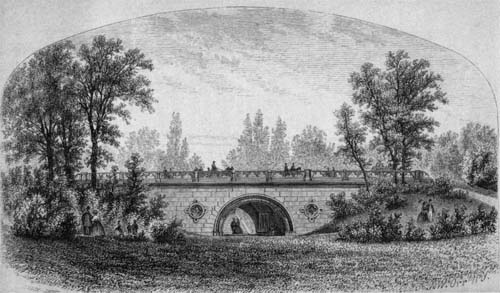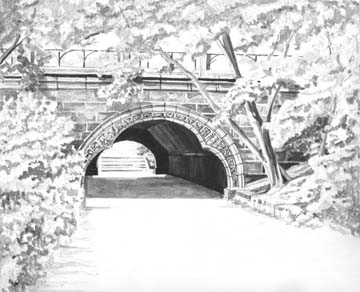The eastern side of Trefoil Arch has one of the most distinctive facades of all park archways. A round trefoil, which explains the name, frames the archway entrance in the Gothic style with not one, but two focal points equidistant from the center, a trefoil being an ornament in a three-lobe pattern. The coping has an uncomplicated but beautiful design of richly carved incisive floral pattern. In the flanking walls are quatrefoils in round frames which, in turn, are bordered by four small circles.
The west side of Trefoil, by contrast, has a round archway. Instead of the floral voussoirs of the east archway, the voussoirs on the west are rusticated and have a curved face. The walls to either side of the archway here have a tooled surface. Also, on the west, there are buttresses that rise to round posts with floral relief.
Perhaps most surprising of all is that the revetment is brownstone throughout. In a generation when brownstone, from the banks of the Passaic and Connecticut Rivers, spread throughout the city and beyond, it was not the favored stone for the park bridges. That distinction Vaux reserved for New Brunswick sandstone. The tunnel inside is lined with common brick under wood sheathing. Cast iron was used for the east railing. Trefoil was completed in 1862 on the designs of Calvert Vaux and Jacob Wrey Mould.
Trefoil is under the East Drive on the path leading from Conservatory Pond to the Lake and Boathouse, in line with 73rd and 74th Streets. Its span is 15 feet 10 inches between abutments, with the highest point 11 feet 9 inches above the path. The underpass is 66 feet and the railing 110 feet long. A statue of Hans Christian Andersen stands nearby. The Board of Commissioners of the Central Park noted a number of similarities between the Terrace Bridge and Trefoil Arch in their Fifth Annual Report for 1861. Both carry a carriage road and path over another path; both have the roadway above resting on similar wrought-iron girders; both stand on a foundation of rubble stone masonry. The Terrace, a much larger undertaking that connects the Mall and the Bethesda Fountain, represents the grandeur of Central Park. But both structures feature Mould's artistry and provide passages to important vistas.
Trefoil was restored in 1983-85 at a cost of over $300,000.

View of round archway on west facade. Lithograph.
Seventh Annual Report, Central Park, for 1863.



